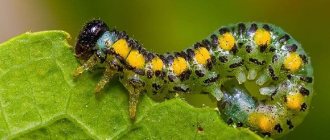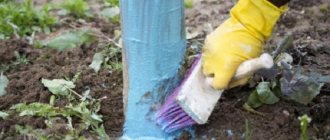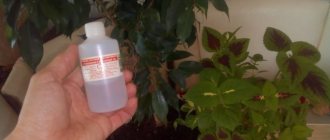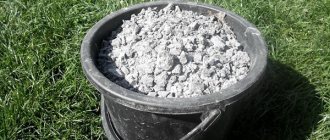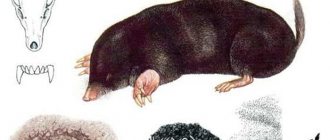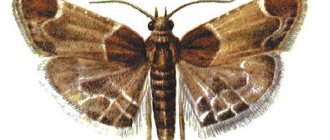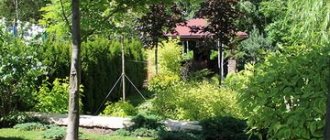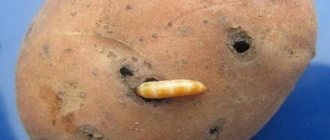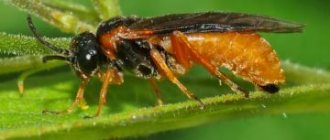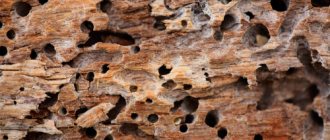The chestnut moth (another name is the Ohrid miner, lat. Cameraria ohridella) is one of the varieties of this ubiquitous pest. You can’t lure this insect into your house, but you can’t drive it out of the park and forest. It is also called the mining moth due to the fact that the insect gnaws long passages-voids (mines) in the leaves, where it lays its eggs. Having settled on one tree, the chestnut leaf miner can spread to the entire planting: scientists have found that a single colony of this pest can completely destroy several deciduous trees in a season. Visually, the presence of this moth on chestnuts is determined when the tree already has transparent, withered leaves with eaten green matter, that is, when it is actually too late to save this plant - but it is necessary to fight. Otherwise, the pest will flutter onto healthy trees and begin to destroy them.
A little about the chestnut moth
The chestnut leaf miner is a voracious and therefore dangerous insect that prefers chestnut (green mass of leaves) and related trees as food. It received the name “miner” because of its characteristic feature of laying eggs in inconspicuous passages hidden in the thickness of the leaf. Such passages, which are made by insect pests, are called “mines” by botanists.
The caterpillar of this pest bites into the pulp of the leaf and massively damages it, thereby causing irreparable damage to the tree. Its presence can be determined in the spring by the cloud of small, inconspicuous moths swarming over the trees. Their size can be judged by the fact that with a full wingspan they reach a centimeter. A swarming cloud means that the chestnut moth is celebrating the mating season en masse: the moths are looking for a mate, then the fertilized female lays eggs, after which the larvae hatch and the entire development cycle repeats.
In the photo, this pest is harmless and even some may find it attractive due to its terracotta-red color. But foresters, green farm workers and botanists can give a long lecture about the damage these cute creatures cause to green spaces and how difficult it is to fight them.
The chestnut miner, like most insect pests of wildlife, undergoes cyclical changes in its activity: after a two-year active cycle, when caterpillars destroy entire plantings, a 3-4-year lull occurs, but for those who care about the health of trees, this is not enough comfort. It takes many years for a chestnut seedling to grow into an adult tree, and if control measures are not taken, the chestnut moth will devour the young trees.
One clutch of chestnut moth contains an average of 50 eggs. After a maximum of 3 days, a larva hatches from the egg - a whitish worm. At this stage, the moth can neither be detected nor therefore killed: it is reliably covered by the leaf in which it is located and on which it feeds.
The first, second and third stages of development of the chestnut moth are the growth and development of the larva “at home”, in the mined passage. The microscopic worm can only feed on chestnut juice and is not strong enough to actively move into the depths of the greenery. But as it grows, the course begins to gradually grow deeper.
At the fourth stage, the larva finally turns into a caterpillar, which needs increased nutrition. The entire fifth stage is a frantic devouring of fiber and green mass. It is often at this stage that the moth is noticed. And at this time, you can still save, if not the tree itself, which is covered with insects, then at least the surrounding trees.
The chestnut leaf miner caterpillar needs to grow to enter its sixth and final stage as a healthy insect with an adequate supply of nutrients. This is necessary so that the caterpillar pupates safely before turning into an adult. The closer the pupal phase, the thicker and more phlegmatic the chestnut miner. She loses interest in food because her task is to spin the thread with which she will wrap herself in a cocoon. It is interesting that the caterpillars of this pest do not always do such work; sometimes they are content with cocoons from which moths have already hatched, climb into them and there they transform into a sexually mature individual.
The chestnut moth butterfly makes a hole in the cocoon and climbs out. This happens at the time when flowering clusters appear on the chestnut tree.
Appearance description
The adult moth looks like a butterfly, reaching about a centimeter in full wingspan. Its color is very bright: brick-red body (less often orange) with white spots. Black scales are scattered in disarray on the body and legs. The leaf miner in the photo looks quite cute and harmless, but appearances, as is often the case, are deceiving.
The shape of the moth larva resembles a spindle, its body is painted an unpleasant pale milky color. As the larva develops, it becomes a caterpillar with developed limbs located on the chest and abdominal parts. A mouth opening is gradually formed, with the help of which the pest is able to gnaw through dense chestnut leaves.
Mining moth
According to observations, the activity of the parasite lasts for two years in a row, after which you can forget about it for several years.
How to deal with chestnut leaf miner
The sooner effective control methods are found, the greater the hope that it will be possible to save chestnuts from death. Without leaves, without vegetative mass, a tree will not be able to breathe, the process of photosynthesis will not be available to it. This means that the tree will die.
But this is not the only problem. The chestnut leaf miner is a carrier of various viral diseases that affect plants and trees. Therefore, large colonies of this insect can cause epidemics. Parks, city gardens and other inner-city plantings are mainly affected. A particularly massive effect of leafmining moth damage is observed in greenhouse farms where tree seedlings are grown. A favorable external environment and a large amount of tasty and tender green foliage contribute to the proliferation of the pest and make the fight against insects very difficult.
To get rid of the chestnut moth, as well as its close relatives (burdock moth, cabbage moth and others), you can use the following methods:
- chemical;
- biological;
- biochemical
- mechanical.
The most effective fight and protection is complex, so you need to use a system of measures and methods.
Varieties of moths
Before you start fighting the parasite, it’s worth figuring out what type of butterfly can live in your neighborhood:
- The fur coat is a grayish-yellow butterfly with small black spots on its wings. Lives in dark closets with outerwear. To get food for itself, it can even chew through a thick plastic bag. If he doesn’t find any goodies in his clothes, he begins to eat feathers in pillows and books.
- Furniture - this is a very attractive species with a golden-yellow color, which settles in upholstered furniture and feeds on upholstery fabric, but is not averse to trying a fur coat, if the owner of the apartment has one.
- The dress butterfly is a butterfly with yellow-violet wings that eats everything without understanding. Clothes turn into unnecessary trash with large holes.
- Food - a small insect of the moth family. The wings are striped brown or gray with dark spots. It not only eats food, but also poisons it with its excrement. Eating them is strictly prohibited, as the toxins can cause severe poisoning.
Biological method
The safest method - biological - involves the use of its natural enemies to combat the chestnut moth. These are mainly various birds, but are capable of infecting moths and other insects.
Birds include sparrows, tits and starlings. For them, larvae and caterpillars, as well as adult butterflies, are a favorite delicacy. Plus, birds have keen eyesight and are able to see pests even at that stage when the human eye is not able to detect them on chestnut trees. Therefore, the bird population should be attracted in every possible way to city gardens and parks, birdhouses should be made for them, and in winter, feeders should be installed with the food that is suitable for this type of bird.
The chestnut moth is afraid of certain beetles and tree bugs, which are not averse to introducing this insect into their diet. There is another very interesting insect - the trichogramma ichneumon, which lays its eggs directly in the body of the larvae of other insects, including this moth. The remedy is fail-safe: the larva will inevitably die, since it is devoured from the inside by a merciless parasite. But it is precisely the parasitic nature of Trichogramma that makes this method not very popular, since it is undesirable to contribute to the growth of the population of any parasitic forms.
Description and appearance
The pest received its name from the geographical location of the area in which these insects were first discovered in the 1980s - the vicinity of Lake Ohrid in Macedonia. The first description of the leaf miner was made by local biologists G. Deshka and N. Dimic.
Initially, the pest was considered a relict Balkan species, but gradually the moth spread northward throughout Europe, from Croatia, Austria (1989), Germany (1994) to the Scandinavian countries (2002) and even to the UK. In Russia, the chestnut moth annually affects trees in the Central regions (since 2005) and the Kaliningrad region (since 2003). According to census estimates, the rate of spread of the pest in some countries reached 100 km/year.
An adult Ohrid miner looks like a small butterfly - the body length is 7 mm, the wingspan is up to 10 mm. The body is brown, the front wings are distinguished by a bright motley pattern and white lines on a brown-red background, the hind wings are light gray. White paws are decorated with black dots. The insect was called a leaf miner because of its ability to make passages (mines) in leaves.
Scientists classify the chestnut leaf miner as a member of the moth family, which is a species of butterfly that can invade the territory of other species. The development cycle of the pest consists of a two-year active period, when the caterpillars emerging from eggs are capable of destroying large areas of planted trees. Then follows 3-4 years of calm.
Development
One of the main features of the development of the chestnut leaf miner and other species of the family is hypermetamorphosis - a method of development in which caterpillars of different ages differ sharply; The caterpillar goes through six phases of development, while the caterpillars of the first - third instars differ from the caterpillars of the fourth and fifth instars in their lifestyle and nutrition, which, in turn, is reflected in their external differences. In the sixth phase of development, the caterpillars spin silk and do not feed.
Caterpillars of the first three phases of development feed only on plant sap (therefore this stage is called the “sap phase”) and form mines in the epidermal layer of the leaf or directly under the skin. Caterpillars of the fourth and fifth phases move from feeding on cell sap to feeding on the tissues themselves of the upper part of the mesophyll of the leaf (the so-called “tissue-eating phase”), while forming more spacious and deeper mines in the leaf. The body of these caterpillars becomes more or less cylindrical, and they acquire well-developed thoracic and abdominal legs. Their head becomes semi-prognathic and their mouthparts are well developed. Caterpillars in the sixth phase of development do not feed (the “non-feeding phase”), but spin silk to build a cocoon. Caterpillars at this stage of development are distinguished by a reduced oral apparatus, a well-developed spinning apparatus and a more fusiform body shape. For 20-45 days, depending on climate and season. According to Gerasimov A.M. (1952), in the genus Camereria
within the sixth phase, two ages are distinguished: in the first, the caterpillars make the lining of the cocoon, in the second - its inner part; Moreover, caterpillars ready to pupate are able to colonize cocoons of previous generations.
Having emerged from the eggs, the first instar caterpillars penetrate under the cuticle into the epidermal layer of the leaf of the host plant. There they begin to absorb the juice, usually making a straight, slightly curved passage along the vein. This passage in the epidermal part is silvery in color, 0.7-1.5 mm long and 0.3-0.5 mm wide. The excrement of the caterpillar in this section of the mine shows a black central line on it (0.05 mm wide at the beginning and 0.08 at the end), which is formed by sections connected by spots. Then the caterpillar forms a spot-like mine with a diameter of 1 mm in the epidermal layer of the leaf, where it begins to molt. At this point, the line of excrement forms a spot-like part of an irregular spherical shape. Sometimes the mottled part of the mine is pale brown. Caterpillars that form such mines can already begin to feed on the juice of the cells of the upper layer of plastid parenchyma.
Caterpillars of the second instar completely switch to feeding on the cell sap of the leaf of the host plant. By the end of the second instar, the larvae form a round mine with a diameter of 2-3 mm. Third instar caterpillars still feed on cell sap in the upper layer of the palisade parenchyma. First, the caterpillars expand the mines in a circle, with excrement completely covering the bottom of the mine, forming concentric black circles. Round mine with a diameter of 6-8 mm, dark. At the fourth instar, the caterpillars switch from feeding on sap to feeding on tissues of all layers of the palisade parenchyma. The average length of the mine is already 16 mm. At the fifth instar, the caterpillars continue to feed on tissues. The mine is from 18 to 31 mm long and from 6-8 to 12-14 mm wide. Sixth instar caterpillars do not feed at all. They first clear the site of exuviae and head capsules of previous instars to build a cocoon and get down to business.
In nature, adult insects appear at the very beginning of chestnut flowering and the appearance of petals. Butterflies hatch (appear) from pupae mainly in the first half of the day. In the afternoon there are single cases of hatching: 52.
Reproduction
Each female chestnut leaf miner lays 20-80 green eggs with a diameter of 0.2-0.3 mm during its life. On one leaf plate on the front side there may be several dozen eggs laid by different females. After 4-21 days (the speed depends on the ambient temperature), larvae emerge from them in the form of white worms, which penetrate deep into the layers of the leaf plate, moving along the veins, and feed on plant sap. The passages formed by the caterpillars are silver in color and up to 1.5 mm long.
The development of the caterpillar goes through 6 phases over 30-45 days and as it grows, its size increases to 5.5 mm. It has a light yellow or greenish body covered with hairs. At the last stage, the caterpillar stops feeding and begins spinning and building a cocoon.
At the next stage, the caterpillar turns into a pupa, which is covered with hairs and has curved hooks on its abdomen. Such devices help it hold on to the edges of the mine, protruding from the leaf, which happens before the butterfly flies out.
Caterpillar of the Chestnut moth.
Nutrition
Insects feed on plant leaves, and the variety is so great that it boggles the imagination. Even conifers are amazed by their miners. Below are lists, far from complete, of quarantine objects, for example, trees:
- horse chestnut;
- Linden;
- holly;
- sycamore;
- Rowan;
- poplar;
- thuja;
- juniper;
- Apple tree;
- cherry;
- citrus.
Shrubs:
- rose;
- rose hip;
- hawthorn;
- honeysuckle;
- spirea.
Herbaceous plants:
- balsam;
- strawberries;
- clover;
- clematis;
- bell;
- centaury;
- dandelion;
- violet, including indoor violet.
Vegetables:
- tomatoes;
- potato;
- cucumbers;
- beet;
- salad;
- parsley;
- cabbage;
- melons;
- and others.
Chemical method
Chemistry, as always, is the most effective - but insecticides are dangerous because they can affect not only pests, but also beneficial insects. And if you need to treat green spaces in places where there are large numbers of people - in gardens, parks, just trees planted along alleys and roads - the drugs can have a toxic effect on humans.
Recently, instead of traditional spraying, so-called stem injections have been used - when insecticides are placed in recesses in the tree trunk. But with the flow of juice, these harmful substances also reach chestnut flowers - and this tree, as you know, is a honey plant. Therefore, bees can die from poisonous nectar.
The safest chemical means of combating chestnut moths is a pheromone trap. Only individuals of a given species will respond to such bait; it is not toxic to the environment. You can buy such products in specialized stores and on the Internet.
Mining moth on cherries and other plants: control methods using the example of one crop
Let's say miners are attracted to the cherry trees in your garden. If the lesions are still minor, you can try to cope with them without the involvement of specialists, using gentle methods. For example:
- collect and burn damaged leaves, including those on neighboring trees;
- hang yellow glue boards: this color attracts insects, and having landed on a layer of glue, the insect will not be able to take off again and will die. The boards need to be changed as the surface is filled;
- introduce insect predators that feed on pests, such as ichneumon wasps;
- miner moths on cherries will feel uncomfortable if the tree is regularly treated with rapeseed or mustard oil;
- you can knock pests off a tree by pouring a stream of water under strong pressure;
- young trees are sometimes covered with non-woven material, which protects the seedling from attacks by mining pests. In the same way, you can, by the way, protect garden beds from moth invasions.
If such methods do not bring results, you will have to turn to insecticides for help. Pyrethrum-based preparations are considered the most effective. However, it is quite toxic, so a number of rules should be followed when working with the composition:
- protect exposed areas of the body with a mask and gloves;
- spray in the morning and evening during the period of minimal activity of insects that destroy miners;
- carry out the procedure at least five times with breaks of 3-5 days.
Considering that moth larvae are quite tenacious, they can continue their development even after getting into the soil. Therefore, if the area is heavily infected, it is recommended to deep water the beds with a preparation containing pyrethrum.
The main measures to combat leafminer moths on chestnut trees are similar to those described above. But there are also differences. Considering that chestnuts, as a rule, are planted for decorative purposes in places with large crowds of people, namely, in park areas, alleys and public gardens, it is better to replace spraying with insecticides with intra-trunk injections - this method of treatment will cause less harm to the environment.
It should also be borne in mind that miners adapt quite quickly to new conditions, so during prolonged use of the same insecticidal preparation, its effectiveness may decrease. In this case, it is worth changing the product to one that is similar in effect, but based on a different component.
Mechanical methods
The only simple mechanical method that can affect the chestnut moth is treating the tree crowns with a powerful stream of water. Such a shower knocks down the individuals on the leaves, and wets the wings of swarming insects and nails them to the ground. But it is impossible to destroy the eggs and larvae inside the leaves in this way.
Mechanical control can also include preventive measures. This is primarily a seasonal cleaning - you need to collect all the fallen leaves and burn them. If dried branches are visible on the tree, they must be removed and also burned.
Destruction
If the enemy does not surrender, he is destroyed. This famous phrase is quite applicable in our case. For control, various means are used against leafmining moths. They can be entered in three ways:
- spraying on leaves;
- application to the soil;
- injection into the trunk.
The simplest and most affordable way is to spray the leaves of plants with anti-mining moth preparations. This procedure is carried out every time before a mass flight of insects.
The introduction of chemicals into the soil is undesirable, since it can not only harm the soil inhabitants, but also penetrate into the tissues of the fruits eaten. This, by the way, also applies to injections into the trunk, which is also very expensive.
To treat plants against leafmining moths, it is recommended to use the following insecticides:
- "Bi-58 new";
- "Dimilin";
- "Karate";
- "Confidor";
- "Aktara".
What a mining moth can do to chestnuts, watch in this video:
The chestnut leaf miner is a formidable pest that not only spoils the decorative appearance of chestnut leaves, but can also cause the death of trees. Let's consider the main methods of combating this insect.
As we already noted in the announcement of the article, leaf miner can cause the death of chestnut trees. To prevent this from happening, it is necessary to combat the pest in advance. If you have noticed earlier that chestnut leaves begin to lose their decorative appearance at the beginning of summer, rusty spots appear on them, and by the end of summer almost all the leaves on the trees become diseased, then most likely the cause is a leaf miner. The danger lies in the fact that the activity of this pest is cyclical. And if in previous years the trees withstood the attack of the insect, then there is no guarantee that next year the number of moths will be the same and the trees will not die. For example, in the summer of 2014, an outbreak of leafminer moths was observed in the Moscow region. The outbreak began due to a general decrease in precipitation levels. Any outbreak lasts at least two years, so we can confidently predict an increase in the moth population in the summer of 2015, regardless of weather conditions and other environmental factors.
Knowing the biology of the insect, you can take care of the health of chestnuts in advance. As preventive methods of combating leafminer moths, insecticidal injections of trees or spraying of crowns with long-acting insecticides are used. It is advisable to hold these events in May-June.
If a moth attack has already occurred, then it is necessary to add fungicide treatment to the listed measures, since mining moths often infect the tree with dangerous fungal diseases. Depending on the type of fungicide selected, you can treat the crown from the outside or inject the drug directly into the trunk.
It should be remembered that all drugs that are used to combat leafminer moths are quite harmful to the environment and humans. Therefore, it is always preferable to use the intra-stem injection method. In this case, the effective dose of the drugs is very small, and the efficiency is higher than with traditional spraying of crowns. Injections are effective both for prevention and for already existing moth attacks. In the first case, the moth prefers not to attack such trees; in the second, the moth larvae die almost immediately after introducing the drug into the trunk. The huge advantage of this method is its safety for people, animals and the plant itself. Large doses of insecticides and especially fungicides can inhibit the plant; this does not happen when using intra-stem injections. However, this method also has its drawback - its high cost.
Chestnut miner
Damages the leaves of horse chestnut, which grows in natural forests in the Balkans, and in other countries is used for landscaping parks, squares and streets. This miner was first discovered near Lake Ohrid in Macedonia on the border with Albania in the 1980s. and received the name “Ohrid miner”. This species quickly spread throughout Europe, and in recent years it is found in almost all regions. Three generations of the chestnut leaf miner develop during the season, with the mass flight of the first generation butterflies occurring during the chestnut flowering period. The pupae of the last generation overwinter in mines in fallen leaves.
Acacia miners
White acacia, or robinia, as an ornamental species at the beginning of the 17th century. brought to Europe, at the end of the 18th century - to Ukraine. This breed is widely used, particularly in hedges. Acacia miner moths entered Europe from North America about 30 years ago and have 2-3 generations per year. The two types of mines are easily distinguishable in appearance.
Linden moth (linden miner).
Described in Japan in 1963. Over two decades, it spread to Primorye, Korea, and penetrated into the European part of Russia, Ukraine and many European countries. Linden miner butterflies overwinter in cracks in the bark of linden trees, laying eggs on the lower surface of the leaves after they have completely bloomed. Butterflies of the summer generation emerge in early July, and butterflies that will spend the winter appear in September.
Arborvitae moth.
Penetrated into Europe from North America in the early 70s. XX century Inhabits thuja occidentalis and Lawson's cypress. Has one generation per year.
The larvae mine apical shoots and overwinter in mines. The needles turn brown and the infested shoots die.
Juniper moth.
Damages common juniper needles. Caterpillars overwinter in dense web tubes. In the spring, the caterpillars continue to feed and pupate in early May. The new generation of caterpillars appears in June and feeds until autumn. They mine the needles and entwine juniper branches with cobwebs, which leads to yellowing of the needles and loss of decorativeness of the plants.
Among ornamental shrubs, miners damage: roses, rhododendron. Holly holly. On the leaves of rose bushes you can notice light spots (the result of piercing by the pink leafminer when laying eggs) and winding passages. Rhododendron leaves are damaged by the azalea moth (Caloptiliaazaleella). Its caterpillars are quite large - up to 1 cm in length. Damaged leaves dry out, crumble and fall off. Adult caterpillars crawl onto adjacent healthy leaves, roll them into tubes and continue their development there. They pupate on the underside of leaves in cocoons. On holly, leaf miner flies are also detected by the presence of punctures and burrows.
Why is this pest dangerous for plants?
During the season, two generations of moths occur; the parasite develops quickly and actively. Butterflies overwinter with moths, pupate in the bark and awaken in early spring. The female leaf miner lays larvae on the upper side of the leaf. Caterpillars appear in early June (this is the first generation). They actively feed on the foliage of trees, causing them great damage.
An observant gardener will be able to notice narrow and winding passages on damaged leaves, which are called “mines.” The color of the tunnels may vary depending on what type of leafminer moth has settled on the plant. Affected leaves often fall off prematurely, and the fruits of the plant do not receive enough essential substances due to the attack on the nutrient sap.
If the damage is severe and a lot of nutritious cell sap is drunk, then the plant, even the tree, becomes weak. In winter, such a tree risks dying because it cannot withstand extreme cold.
The second generation of caterpillars develops around the end of July or the very beginning of August. It should be taken into account that the number of the second generation of leafminer moths on the same plant will be several times greater.
Harm
Caterpillars
Leafminer moths
feed on plant foliage
, causing them great damage.
Leaves
that are affected by the pest
fall prematurely
, and
the fruits do not receive
the required amount
of nutrients.
Reference!
In case of severe damage to plants and trees, the yield decreases, the amount of sugars, ascorbic acid and microelements in the fruits becomes less, the buds stop forming, the plant weakens and there is a risk of its death in winter.
Mining moths are dangerous because they are difficult to notice in the early stages of the lesion.
, and when the signs become obvious, it is almost impossible to save the plant.
For example, after several years
of life of an insect colony on a tree, most
of
its
crown dries out
.
Important!
Adult pests carry viruses of many diseases, which is why epidemics can occur in parks or greenhouses infected by them.
Laying a mine: how does it happen?
The mine is always eaten by a larva, but first an adult insect must fly to the plant and lay an egg. Do small insects swarm around your plants, do they “cover” the trunks? This may well be a massive outbreak of one or more types of miners. If a butterfly, beetle, fly or sawfly crawls along a leaf, stops, and then a whitish, yellowish or milky-green bubble remains in this place, egg laying is in full swing.
tomato leaf damaged by miners
The larvae of many leaf miners do not come to the surface of the leaf, but bite into it directly through the egg wall. The mine turns out to be completely closed - its entrance hole is hidden by the shell of the egg. After a week, it overgrows, and the larva becomes completely isolated from the outside world.
Stages of development
One leaf miner lays about 300 eggs. Such masonry can be seen on the lower or upper side of the sheet. After 10-15 days, larvae emerge from the eggs and immediately begin to gnaw through the internal passages in the leaves. From the outside, such passages look like swollen beige or brown patterns. The larvae develop in several stages: during the first three phases of development, they feed only on the juice of the leaves.
At the fourth stage, a caterpillar is formed from the larva, which feeds on fiber and leaf tissue, and the passages formed by it become wider and more clearly visible. In the last, sixth phase, the caterpillar stops feeding and begins the pupation process.
The resulting pupa is dark brown, 5-6 mm long, covered with short light hair. The process of hatching an adult from the pupa takes about 2 weeks. Therefore, at least three generations of moths can appear in one season.
In the form of a pupa, the mining moth tolerates frost well, but most of the caterpillars do not have time to pupate by the onset of winter, overwinter in cracks in tree bark, and often die.
Pupae overwinter under trees, in fallen leaves. In the spring, when the temperature rises to +8-10C, butterflies fly out of the pupae and begin to lay eggs.
The secretive lifestyle of mining insects
Mining insects are protected by plant tissues and are not afraid of airborne pollutants. The evaporation of water from the surface of the leaves protects the leaf miner from extremely high temperatures, and the good thermal conductivity of the tissues protects it from extremely low temperatures.
These pests relatively rarely die from attacks by predators and parasites, and the isolation of their larvae prevents the spread of disease. Therefore, on any plant - from plantain to two-hundred-year-old larch - at least one species of miners lives. They are found among beetles, dipterans and hymenoptera, but the vast majority of miners are butterflies.
mining insects
Methods of chemical protection against mines
When there are few mines (1-2 per 30-50 leaves), you can collect and destroy damaged leaves until the mines stop appearing. In this case, it is enough to bury the leaves to a depth of 10 cm. The larvae of most miners are not suitable for “underground work,” but even if they get out of the ground, they will no longer be able to climb into the crown along the tree trunk. In advanced cases (1–2 mins per leaf), treatment with biological or chemical agents is necessary. Systemic insecticides such as Actellik are suitable.
miners on nasturtium leaves
Types of moths
There are several types of moths. For example:
- Fur moth. This type of moth prefers products made from natural fur. These can be hats, jackets, fur coats, car covers, clothing covers, etc.
- Grain moth. Prefers containers in which wheat, semolina, nuts, barley, as well as seeds of various plants are stored. Moth infestation of cereals can be determined by the presence of a thin enveloping web.
- Rye moth. It reproduces on cereal crops directly in the field.
- Clothes moth. This type of moth lives in houses and apartments. This is a fairly large pest with colorful wings. Lives where a lot of clothes are stored. It feeds on wool fibers, so it often gnaws large holes in clothes.
- Cabbage moth. The pest breeds in cabbage beds. It is distinguished by its brown wings.
- Barley moth. It prefers barley grains, in which it gnaws holes and penetrates into the grains.
- Furniture moth. She prefers to live in upholstered furniture, where she eats stuffing and upholstery material.
Watch this video on YouTube
Morphology
Imago
Illustration from the book “BioRisk: Biodiversity & Ecosystem Risk Assessment” (2010)
The body length of the butterfly is 6-7 mm, the wingspan is 7-9.5 mm. The head is covered with reddish hairs. The last segment of the antennae almost reaches the top of the fore wings. The chest is soil-colored. The forewings are reddish-brown, with white basal lines, two outwardly curved white lines, which are thinly bordered on the outer side by a black stripe, and two pairs of curved costal and dorsal lines. The apical part (apex) of the fore wings is randomly strewn with blackish scales. The hind wings and abdomen are gray. Legs are white with black dots.
Egg
The egg has a diameter of 0.27-0.32 mm and is teardrop-shaped; light green color. The exuvium of the egg after the caterpillar hatches becomes light, grayish-white; its shape is oval, slightly flattened.
Caterpillars
The first instar caterpillar is 0.8 mm long, light green, translucent. The body is flattened, strongly narrowed towards the posterior end. The first thoracic segment is wide (approximately 0.2 mm), noticeably wider than the other thoracic segments. The head capsule is 0.1–0.15 mm long and 0.11–0.2 mm wide, golden brown, almost transparent.
The second instar caterpillar is 2 mm long, light green, translucent, with light hairs. The head capsule is 0.24 mm long and 0.25 mm wide, golden brown, almost transparent. The first thoracic segment is wide - on average 0.3 mm.
Third instar caterpillars are approximately 3.5 mm long, yellowish-green or pale yellow. Body covered with sparse light hairs; dorsal setae on the second–third thoracic and first–eighth abdominal segments are brown. The first segment of the chest is also wider than the others, up to 0.75 mm wide. The head capsule is 0.35 mm long and 0.40 mm wide, light brown, shiny.
The fourth stage caterpillars are 4.5 mm long and are usually light green or yellowish green. The body is more or less cylindrical, noticeably narrowing towards the posterior end after the fifth abdominal segment. The first segment of the chest is 0.78 mm wide. The head capsule is the same color as the body, 0.35-0.4 mm long and 0.45-0.5 mm wide.
Caterpillars of the fifth instar are 4.5-6 mm long, greenish-gray. The body is covered with hairs; dorsal setae of thorax and abdomen black. The first segment of the chest is 1.1 mm, the widest is now the third segment, which is 1.26 mm wide. The head capsule is brown.
Sixth instar caterpillars are 4.2–5.5 mm long. The body is matte, pale green or whitish-yellow, with light hairs, fusiform. The first thoracic segment is narrower than the second and third segments and a number of subsequent abdominal segments. The head capsule is 0.5 mm long and 0.45 mm wide, and the color is almost the same as the body: from pale green to pale brown.
Doll
The pupa is 3.25–5.7 mm long, dark brown, with short light hairs. The top of the head has a characteristic beak-shaped shape. On each, from the second to the third, abdominal section there is a pair of curved hooks, with which the pupa, protruding from the mine, holds on to the cocoon or epidermis - the outer integumentary layer of the leaf, before the butterfly emerges. It is noteworthy that sexual dimorphism at this stage is quite clearly expressed - male pupae are morphologically different from female pupae: in them, unlike female pupae, the seventh segment is distally expanded.
